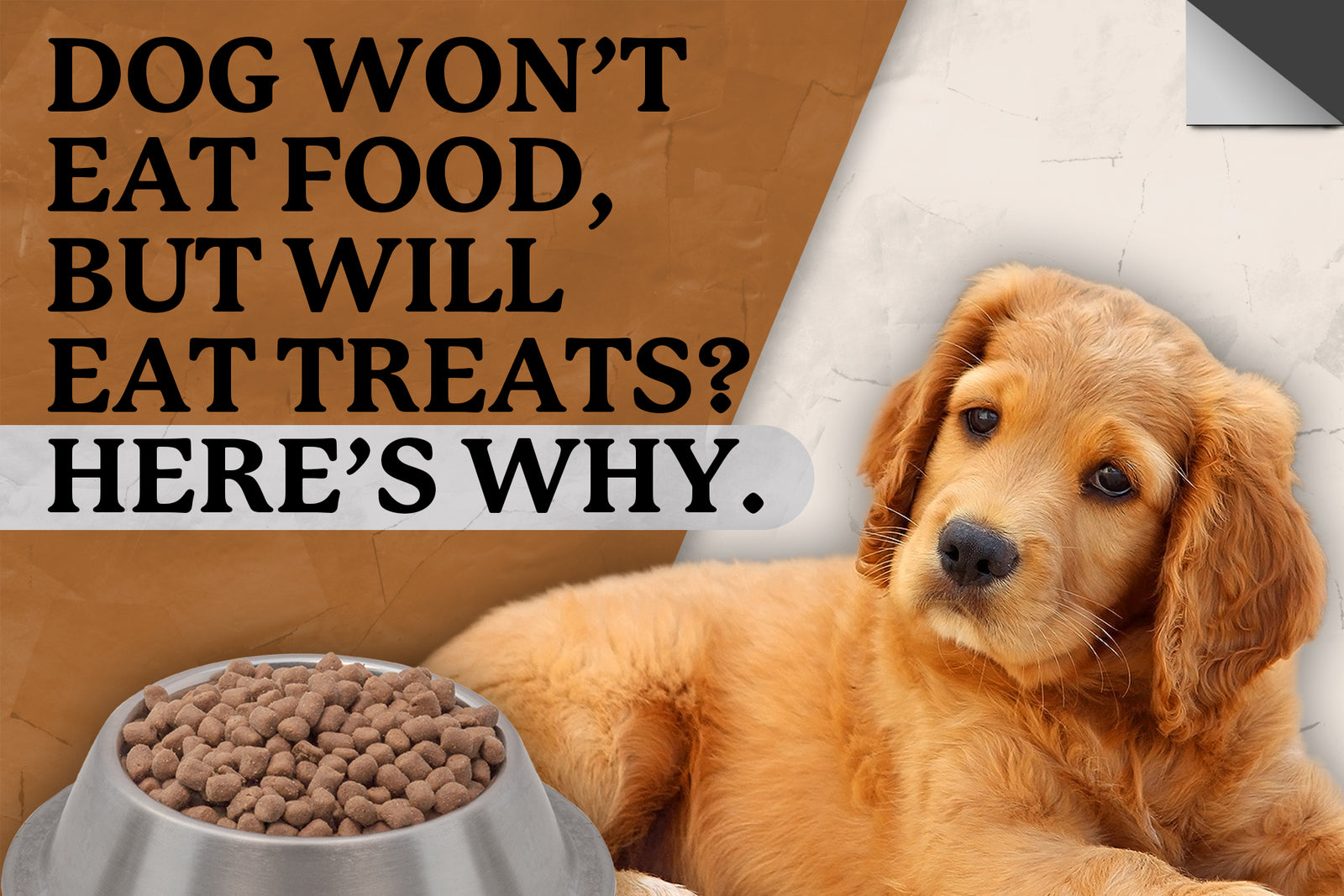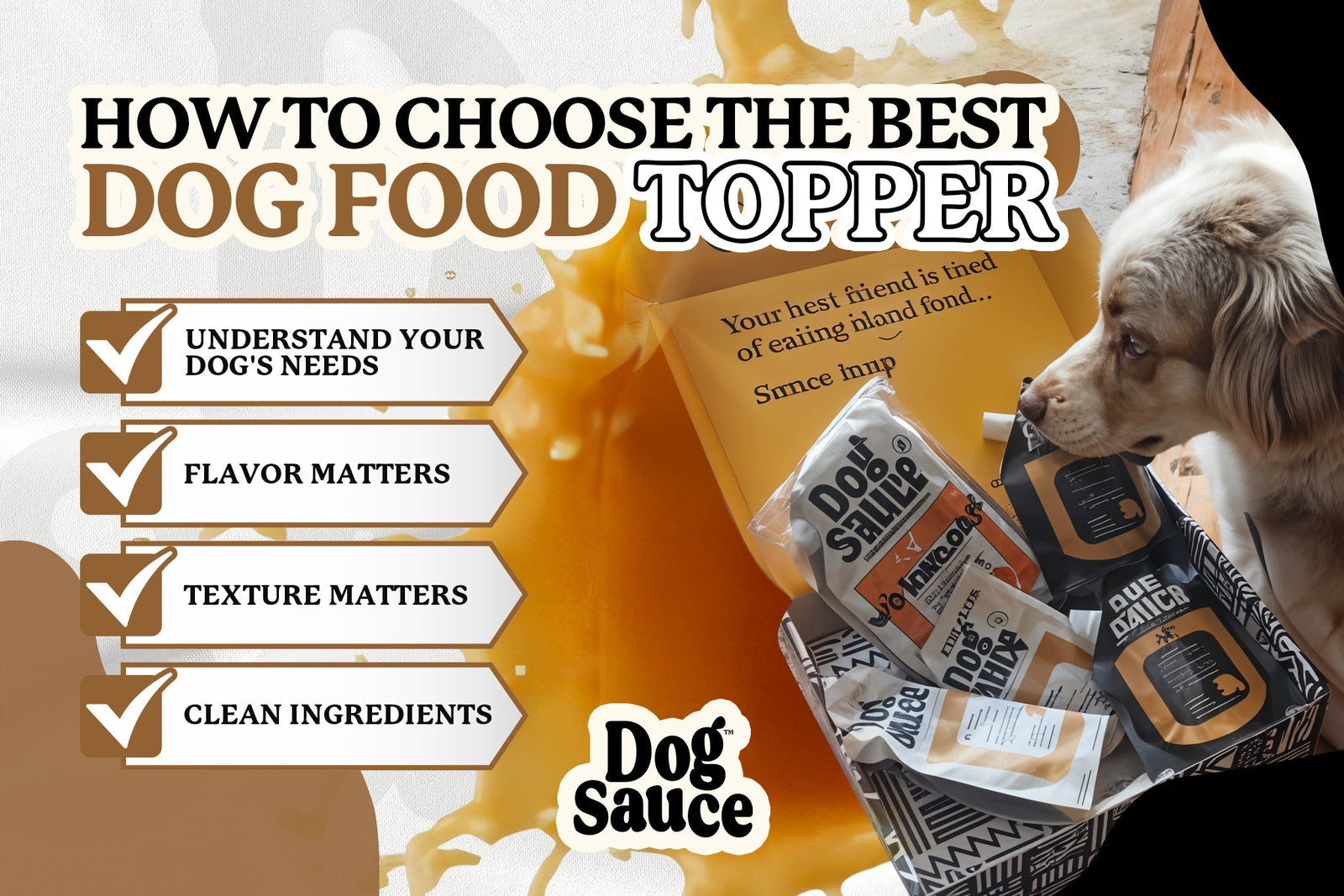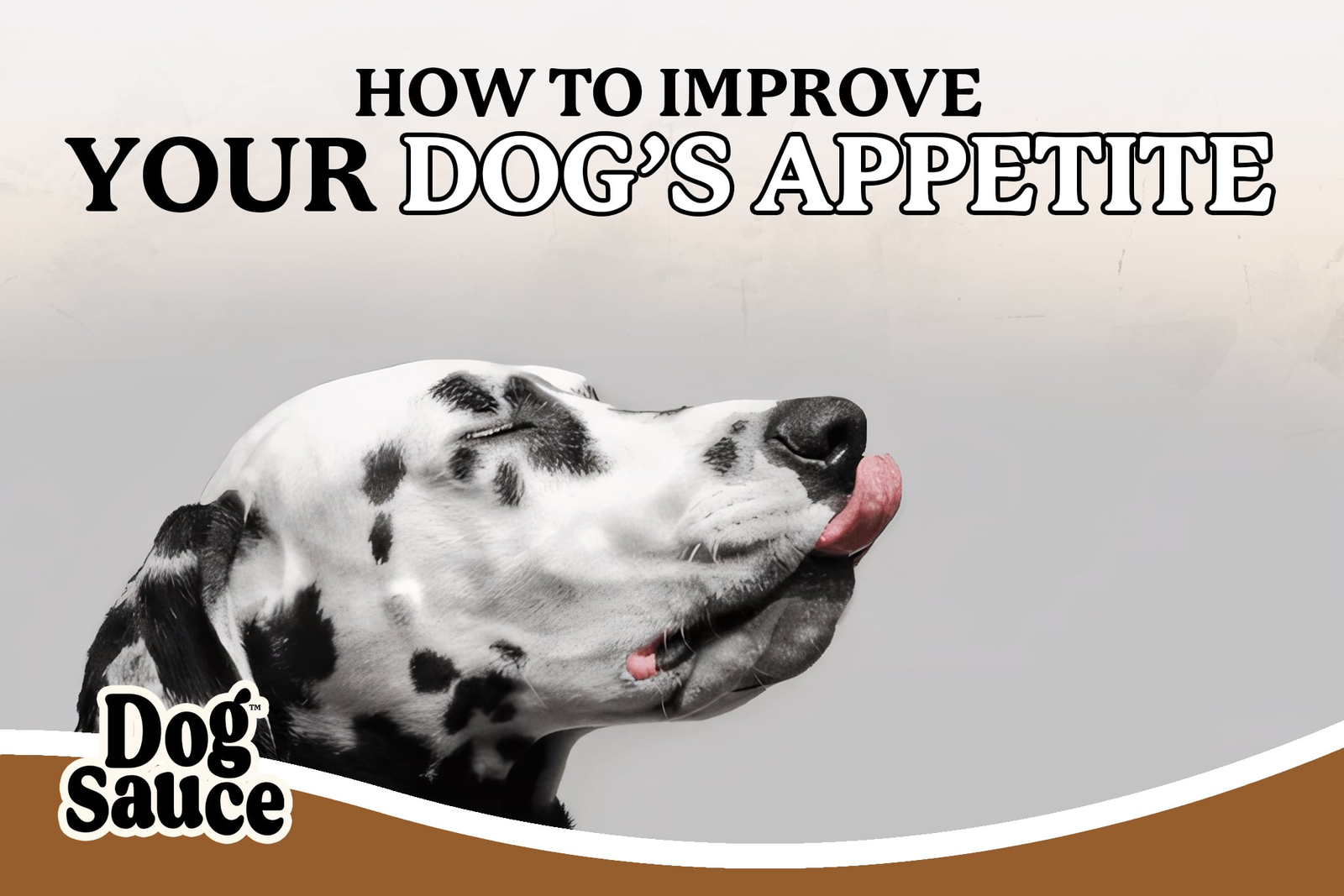🐶 Free shipping on order over $75
🐶 Free shipping on order over $75
Shop

Dog Won’t Eat Food, But Will Eat Treats? Here’s Why
If your dog won’t eat their kibble but happily devours treats, you’re not alone! Partial anorexia is a common issue among dogs, and there could be several reasons for it.
But don’t worry, pet parents! You can fix this problem and help your dog eat their regular food again.
Here are 14 reasons your dog won’t eat their food but will eat treats—and how to end the hunger strike.
14 Reasons Your Dog Won’t Eat Their Food

Diagnosing issues with your dog’s health and diet isn’t always easy because many factors could be at play. But don’t worry; we have everything you need to know to solve this problem.
Here are some common reasons dogs refuse their food and what to do about it:
1. Recent Vaccinations
Vaccinations can sometimes temporarily reduce a dog’s appetite. However, this is usually short-lived, and the dog should return to normal within a day or two.
After vaccinations, ensure your dog stays hydrated and offer bland, easily digestible food like unseasoned chicken and rice. If the loss of appetite persists or other symptoms develop, call your vet.
2. Dislike of the Food
Have you ever hated the taste or texture of food? Sometimes, dogs can feel the same way! Here are some things you can do to address this issue:
-
Add some Dog Sauce to make your dog’s diet tastier (and healthier).
-
Try different high-quality dry dog food brands and flavors.
-
Spruce it with plain, sugar-free Greek yogurt, 100% peanut butter, or unsalted tuna water.
-
Gradually mix new food with the current food to help your dog adjust. Consult your vet if your dog’s picky eating continues, which may indicate an underlying health issue.
3. Preference for Treats
You’d probably choose an Oreo over a bowl of spinach. Your furry friend feels the same way.
To combat this, establish a feeding schedule and limit treats, giving them only as rewards for good behavior or training. Only offer healthy treats and don’t exceed 10% of their daily caloric intake.
You can also use a food puzzle or interactive feeder to make mealtime more fun for your dog.
4. Illness
If your pup isn’t feeling well or has medical issues, it might not want to eat its regular food but could still be convinced to enjoy a tasty treat. This is normal.
If your dog shows other symptoms, such as lethargy, vomiting, diarrhea, or changes in behavior, consult your vet immediately. Your puppy may be refusing food due to an underlying health problem or medical condition.
During recovery, feed your dog bland, easily digestible food and ensure they always have fresh water.
5. Dental Problems
Dental issues like gum disease, tooth decay, or broken teeth can make eating painful for dogs.
Regular dental check-ups and cleanings are essential to prevent and treat these problems. If you suspect dental pain, get a vet examination.
Softening dry food with water or broth can make it easier for your dog to eat if they have dental issues.
6. Stress or Anxiety
Believe it or not, stress and anxiety can cause dogs to lose their appetite. Common triggers include changes in the environment, routine, or the introduction of new pets, new home, new or people. Has your dog experienced any of these recently?
To help them adjust, maintain a consistent routine, create a calm and safe environment away from other pets, and give them plenty of exercise and mental stimulation.
You can also try calming aids like pheromone diffusers, anxiety wraps, or CBD.
7. Changes in Diet
Switching your dog’s food too quickly can lead to an upset stomach.
If you need to switch their kibble, gradually transition to the new food over 7-10 days by mixing increasing amounts of the new food with the old food. A gradual change allows your dog’s digestive system to adjust to different foods and helps prevent gastrointestinal issues.
8. Spoiled Food
No one wants spoiled food! If their food is expired, your dog might refuse to eat it.
Always check expiration dates and store food in a cool, dry place. I like to use airtight containers to keep it fresher (and tastier) for longer.
9. Boredom
You'd probably get bored if you ate the same thing for every meal. Try different pet foods and flavors to keep your pup interested in their meals. Adding dog-friendly fruits and vegetables or some of our superfood Dog Sauce to their dry kibble can help prevent boredom.
10. Medication Side Effects
Certain medications can reduce a dog’s appetite. When my boy had to get sutures after an unfortunate dog fight, he was loaded up on different painkillers and antibiotics and had a hard time eating.
I worked around this by giving him easily digestible food like unseasoned white rice and chicken. Talk to your vet if your dog is on medication and starts refusing food. They may be able to adjust the dosage or prescribe a different medication.
11. Age-Related Issues
Dogs may begin to eat less as they age, often due to a reduced metabolism or sensory decline. If you have an older dog, consider senior-specific dog food that meets its nutritional needs and is easier to chew and digest.
Mix in “human food” made for dogs, like Dog Sauce.
12. Teething (for Puppies)
Teething can be uncomfortable and reduce a puppy’s appetite. Try giving your pup soft, easily chewable food while it’s teething. Teething toys and chilled items can also help soothe their gums. My puppy loved cold baby carrots to ease his tooth pain!
Consult your vet if your puppy’s appetite doesn’t improve, which could indicate other health issues.
13. Overfeeding
Feeding your dog too much can lead to a lack of appetite. If they know the food is always there and get bored, they’ll stop eating and wait for treats.
To prevent this, only feed your pup at mealtimes and practice portion control based on age, weight, and activity level. Your kibble bag should have a chart indicating the proper amount of food.
Avoid leaving food out for your dog all the time. If they don’t finish it, put it away where they can’t see or reach it. By making them uncertain when they may get food again, they’ll be more encouraged to finish their food when you put it out.
14. Behavioral Issues
Behavioral issues like separation anxiety can affect a dog’s eating habits. These can be difficult to fix, but not impossible.
Look into behavior modification techniques, training, and creating a positive feeding environment. Feed them regularly, away from other pets or loud distractions.
Consult a professional dog trainer or behaviorist if needed.
How to Get Your Dog to Eat Dog Food Again

Here are seven tips to get your picky eater back on their regular food:
1. Stick to a Regular Feeding Schedule
Many dog owners make the mistake of leaving food out for their dogs 24/7.
I get it—dogs are a lot of work, and remembering to feed them on time can be challenging. But I promise it’s worth it!
You can fix most dogs’ eating habits by feeding them daily. How many times per day depends on your dog’s age:
-
Puppies 1-6 months: 4 meals per day
-
Puppies 6-12 months: 2-3 meals per day
-
Adult dogs over one year: 2 meals per day
I love feeding my dog regularly because it’s a great training opportunity. Every mealtime, I make my dog sit, lay down, and wait before he can eat. It teaches him patience and discipline.
2. Add Some Sauce
You like sauce; dogs do, too!
We created our Dog Sauce super food meal topper to help improve your dog’s appetite and provide a nutritional boost for a healthier coat and longer lifespan.
Drizzle an ounce or two of sauce on their kibble, and your picky eater will be eating in no time.
3. Cut Back on Treats
Giving too many treats or table scraps can spoil your dog’s appetite for regular meals. Limit treats to no more than 10% of their daily caloric intake and use them only as rewards for good behavior or training.
If your dog is holding out for treats, put them on a consistent feeding schedule and stick to it. This reinforces the importance of their regular food and makes them less likely to hold out for treats.
When it comes to treats, only use healthy, low-calorie options. More indulgent treats should only be given sparingly.
If you want to work with your dog, consider using their regular kibble as a reward during training sessions.
4. Introduce Variety
Like us, dogs can get bored of eating the same food daily. A balanced diet is suitable for a healthy dog!
To keep your dog interested in its meals, rotate between different high-quality dog foods and flavors or try canned food.
You can also add dog sauce to make meals more exciting and provide extra nutrients for them so they might start eating! Just remember to make the switch gradually over time.
5. Create a Quiet Eating Space
Pet owners: If your dog’s environment is stressful or distracting, they might not eat. Create a quiet, comfortable eating space where your dog can eat undisturbed. Choose a spot away from high-traffic areas, loud noises, and other pets.
If you have multiple pets, consider feeding them separately to prevent competition or anxiety. Crate training your dog and feeding them in the crate can help them.
Related Products

DogSauce Dog Food Topper
Shop NowRelated Articles
The Ultimate Guide to Dog Nutrition
August 27, 2025
How to Choose the Right Dog Food Topper for Your Pet
July 31, 2025
How to Improve Your Dog’s Appetite
July 22, 2025
Subscribe
Sign up to get the latest on sales, new releases and more …
Free Shipping
Free shipping on orders over $75
Money‐Back
Money back guarantee if your dog doesn't like it
Secure Checkout
Fast and smooth payment processing
{"statementLink":"","footerHtml":"","hideMobile":false,"hideTrigger":false,"disableBgProcess":false,"language":"en","position":"left","leadColor":"#146ff8","triggerColor":"#146ff8","triggerRadius":"50%","triggerPositionX":"right","triggerPositionY":"bottom","triggerIcon":"people","triggerSize":"medium","triggerOffsetX":20,"triggerOffsetY":20,"mobile":{"triggerSize":"small","triggerPositionX":"right","triggerPositionY":"bottom","triggerOffsetX":10,"triggerOffsetY":10,"triggerRadius":"50%"}}





